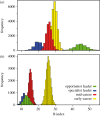The missing metric: quantifying contributions of reviewers
- PMID: 26064609
- PMCID: PMC4448813
- DOI: 10.1098/rsos.140540
The missing metric: quantifying contributions of reviewers
Abstract
The number of contributing reviewers often outnumbers the authors of publications. This has led to apathy towards reviewing and the conclusion that the peer-review system is broken. Given the trade-offs between submitting and reviewing manuscripts, reviewers and authors naturally want visibility for their efforts. While study after study has called for revolutionizing publication practices, the current paradigm does not recognize reviewers' time and expertise. We propose the R-index as a simple way to quantify scientists' contributions as reviewers. We modelled its performance using simulations based on real data to show that early-mid career scientists, who complete high-quality reviews of longer manuscripts within their field, can perform as well as leading scientists reviewing only for high-impact journals. By giving citeable academic recognition for reviewing, R-index will encourage more participation with better reviews, regardless of the career stage. Moreover, the R-index will allow editors to exploit scores to manage and improve their review team, and for journals to promote high average scores as signals of a practical and efficient service to authors. Peer-review is a pervasive necessity across disciplines and the simple utility of this missing metric will credit a valuable aspect of academic productivity without having to revolutionize the current peer-review system.
Keywords: index; peer-review; publication practices; research assessment; science metrics; science policy.
Figures


References
-
- Hochberg ME, Chase JM, Gotelli NJ, Hastings A, Naeem S. 2009. The tragedy of the reviewer commons. Ecol. Lett. 12 2–4. (doi:10.1111/j.1461-0248.2008.01276.x) - DOI - PubMed
-
- Robertson P. 1976. Towards open refereeing. New Sci. 71 19.
-
- Kachewar SG, Sankaye SB. 2013. Reviewer index: a new proposal of rewarding the reviewer. Mens Sana Monogr. 11 274–284. (doi:10.4103/0973-1229.109347) - DOI - PMC - PubMed
-
- Godlee F. 2002. Making reviewers visible: openness, accountability, and credit. JAMA 287 2762–2765. (doi:10.1001/jama.287.21.2762) - DOI - PubMed
-
- Nature Neuroscience. 2005. Revolutionizing peer review? Nat. Neurosci. 8 397. - PubMed
LinkOut - more resources
Full Text Sources
Other Literature Sources
